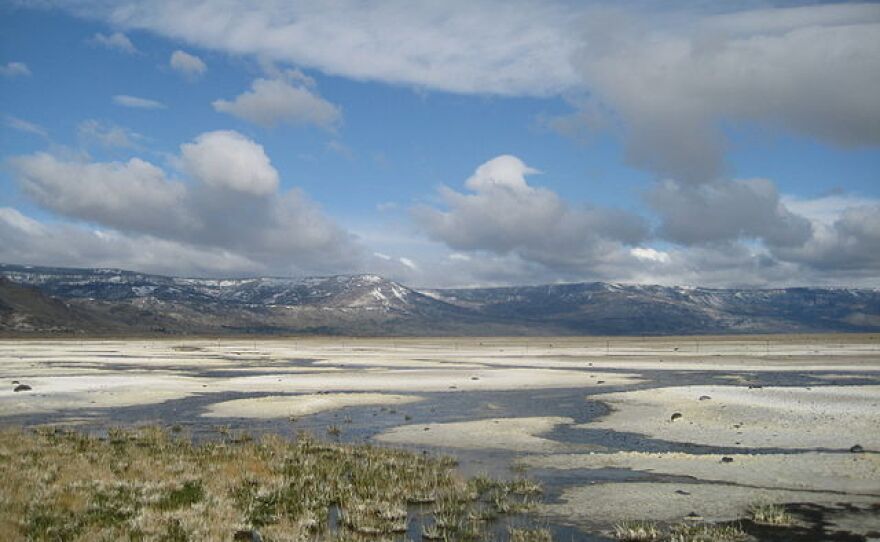I’m writing this in Oregon’s high desert, on the shore of Summer Lake—or, to be more accurate, on the rim of its dry lakebed. It’s August, and I’m here with a group of artists, scientists, and writers, all of us gathered to think about the future of the northern Great Basin in the face of change—most fundamentally, climate change.
Summer Lake was given its name by the explorer John C. Fremont in December, 1843, when he and his survey party stumbled through snow to the edge of a vertical escarpment. To Fremont’s amazement, a green valley and turquoise blue lake spread before them, three thousand feet below. He promptly named the lake Summer Lake, the ridge Winter Ridge—and proceeded to find a way down as quickly as possible!
Such sharp environmental contrasts are the norm in the Great Basin, through time as well as in space. We know this because the region’s arid conditions, which make living here a challenge, are ideal for preserving life’s remains. In lake sediments, packrat stockpiles, and even in exquisitely air-dried human dung (coprolites), an unmatched history of ecological change has been revealed by the painstaking work of geologists, paleontologists, and archeologists. This great body of knowledge has recently been synthesized in a masterful book, The Great Basin: A Natural Prehistory, by Donald K. Grayson of the University of Washington—required reading for anyone interested in the West.
The most dramatic changes in the Great Basin over the past 100,000 years, and continuing to this day, have been the appearance and disappearance of lakes. The Great Basin is comprised of many lesser basins that are topographically connected to some degree, but which have no outlet. In the late Pleistocene, about 15,000 years ago, the Great Basin was a labyrinth of lakes, covering almost 28 million acres by Grayson’s calculation. The largest of these, Lake Bonneville, was almost the size of Lake Michigan, and reached depths well over 1000 feet. Its shriveled remnant is the Great Salt Lake.
Summer Lake, too, was part of a much larger Pleistocene lake, called Lake Chewaucan, which covered 480 square miles and reached a depth of 375 feet. At its springtime maximum these days, Summer Lake is lucky to cover 70 square miles at a maximum depth of three feet. By late summer, the lake has retreated to a puddle at its north end, visible from our lodge halfway down the shoreline only as a thin dark smudge almost lost in the heat waves.
The Pleistocene lakes were in their glory during the last glacial maximum, when the continental ice sheets deflected the jet stream southward. This brought both high precipitation and low evaporation (cool temperatures), which together filled the basins of the Great Basin. In contrast, the greatest retreat of Great Basin lakes occurred during a period of high temperatures and drought sometimes called the Altithermal, from about 7500-4500 years ago. The causes for this climatic shift in the middle Holocene are not well understood, and its effects were not equally severe everywhere. Nevertheless, this period paints a sobering picture of the immediate future of the Great Basin.
The Altithermal appears to have been characterized by temperatures 5–15° F higher than today; in other words, within the range of predicted Great Basin temperatures by the end of this century. And what were the effects of these temperatures? Many Great Basin lakes and marshes virtually disappeared. There was a spike in the frequency of fires, as shown by studies near Lake Tahoe. A variety of mammals associated with sagebrush were replaced in the archeological record by species adapted to drought-tolerant saltbush. The hardy woodrats, whose middens are such a reliable source of data on environmental conditions over millennia, disappeared from many sites, to return only after the end of the drought.
And yes, even those most adaptable creatures, human beings, suffered widespread population declines during the Altithermal. Those that survived were forced to abandon their hunting and fishing lifestyle and adapt to a diet heavy in small, painstakingly gathered seeds (we know this from their, um, coprolites). All in all, Grayson singles out the Altithermal as the least hospitable time for humans in the Great Basin over the past 10,000 years.
This bad time seems to be returning. And the challenges ahead will not be due to climate change alone. Human population density in the Great Basin is far higher than it has ever been, with major cities in Las Vegas, Salt Lake City, and Reno. These urban populations, especially those in Las Vegas, rely on water sources that may not last the century, and most rural residents also depend on readily available water for farming and ranching. It is hard to imagine how these populations can be sustained in the face of conditions approaching those of the Altithermal.
The dry bed, or playa, of Summer Lake, has a stark beauty. Every evening, our group gathered on its salty edge to watch the shadow of Winter Ridge roll smoothly across it as the sun sets. The history of the Great Basin assures us that this lake will be brim-full again—in a thousand, or ten thousand years. But that is cold comfort for the hot days ahead.






